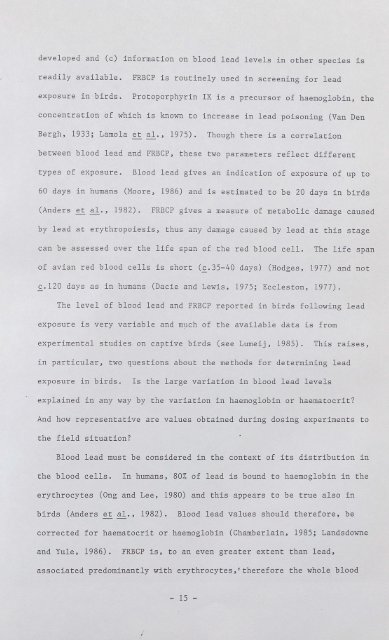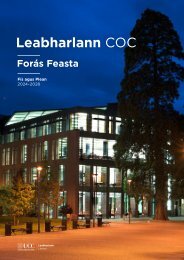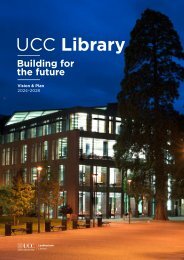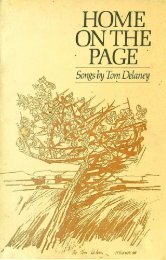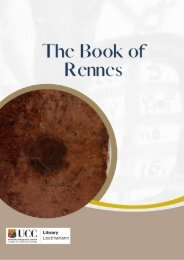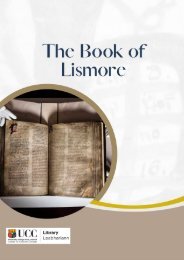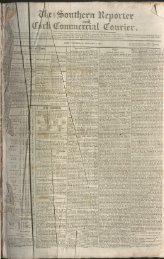Lead Toxicity in Mute Swans
LEAD TOXICITY IN MUTE SWANS Cygnus olor (Gmelin). By JOHN O'HALLORAN A thesis submitted to the National University of Ireland in candidature for the degree of Doctor of Philosophy September 1987
LEAD TOXICITY IN MUTE SWANS
Cygnus olor (Gmelin).
By
JOHN O'HALLORAN
A thesis submitted to the National University of Ireland
in candidature for the degree of Doctor of Philosophy
September 1987
Create successful ePaper yourself
Turn your PDF publications into a flip-book with our unique Google optimized e-Paper software.
developed and (c) <strong>in</strong>formation on blood lead levels <strong>in</strong> other species is<br />
readily available.<br />
FRBCP is rout<strong>in</strong>ely used <strong>in</strong> screen<strong>in</strong>g for lead<br />
exposure <strong>in</strong> birds. Protoporphyr<strong>in</strong> IX is a precursor of haemoglob<strong>in</strong>, the<br />
concentration of which is known to <strong>in</strong>crease <strong>in</strong> lead poison<strong>in</strong>g (Van Den<br />
Bergh, 1933; Lamola et al., 1975).<br />
Though there is a correlation<br />
between blood lead and FRBCP, these two parameters reflect different<br />
types of exposure.<br />
Blood lead gives an <strong>in</strong>dication of exposure of up to<br />
60 days <strong>in</strong> humans (Moore, 1986) and is estimated to be 20 days <strong>in</strong> birds<br />
(Anders et al., 1982).<br />
FRBCP gives a measure of metabolic damage caused<br />
by lead at erythropoiesis, thus any damage caused by lead at this stage<br />
can be assessed over the life span of the red blood cell. The life span<br />
of avian red blood cells is short (£.35-40 days) (Hodges, 1977) and not<br />
£.120 days as <strong>in</strong> humans (Dacie and Lewis, 1975; Eccleston, 1977).<br />
The level of blood lead and FRBCP reported <strong>in</strong> birds follow<strong>in</strong>g lead<br />
exposure is very variable and much of the available data is from<br />
experimental studies on captive birds (see Lumeij, 1985).<br />
This raises,<br />
<strong>in</strong> particular, two questions about the methods for determ<strong>in</strong><strong>in</strong>g lead<br />
exposure <strong>in</strong> birds.<br />
Is the large variation <strong>in</strong> blood lead levels<br />
expla<strong>in</strong>ed <strong>in</strong> any way by the variation <strong>in</strong> haemoglob<strong>in</strong> or haematocrit?<br />
And how representative are values obta<strong>in</strong>ed dur<strong>in</strong>g dos<strong>in</strong>g experiments to<br />
the field situation?<br />
Blood lead must be considered <strong>in</strong> the context of its distribution <strong>in</strong><br />
the blood cells. In humans, 80% of lead is bound to haemoglob<strong>in</strong> <strong>in</strong> the<br />
erythrocytes (Ong and Lee, 1980) and this appears to be true also <strong>in</strong><br />
birds (Anders et al., 1982).<br />
Blood lead values should therefore, be<br />
corrected for haematocrit or haemoglob<strong>in</strong> (Chamberla<strong>in</strong>, 1985; Landsdowne<br />
and Yule, J986).<br />
FRBCP is, to an even greater extent than lead,<br />
associated predom<strong>in</strong>antly with erythrocytes,' therefore the whole blood<br />
- 15 -<br />
/


